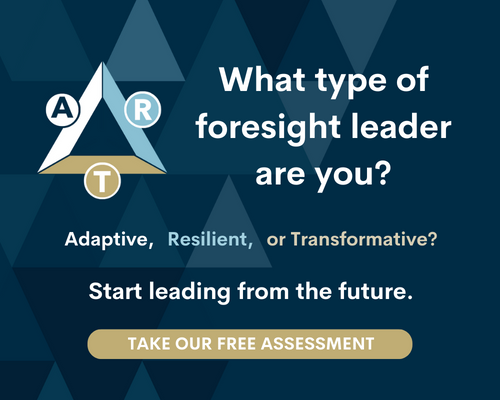Armed Against the Sea of Uncertainties

“Whether ‘tis nobler in the mind to suffer the slings and arrows of outrageous fortune, or to take arms against a sea of troubles and by opposing, end them.”
Imagine, if you will, a dark and stormy night. Terror crackles or rips, or snaps through the streets like a live wire. Panicked voices cry from every corner. Newscasters with shaky voices urge the public to remain calm, to no avail.
Then out of the darkness, with flashing eyes and gnashing teeth, enters the scariest monster, one that could only emerge from the depths of our imagination…the unknown.
While there isn’t really a monster lurking in the shadows of the federal space, the description of this sort of terror regarding the unknown is familiar. Anything that requires determining the future state tends to skew toward a negative response. Reported risks? Bad news. Questioning the “what ifs” of the future? So many pitfalls. Anticipating new policies and technologies? Oh, the humanity!
The intro quote from Shakespeare’s Hamlet provides some insight when describing how to apply foresight in the federal space. While Hamlet’s situation is far more bleak and fictional, his musing can be used to help consider how the government addresses its myriad problems. “Suffering slings and arrows” is akin to being reactive to the situations surrounding the space — making do with few resources, living with initiative uncertainties when top officials continually change, and operating day-to-day with a new challenge landing on your desk.
Fortunately, agencies have started to take arms against this sea of troubles and have started thinking proactively about the future of the government; these practitioners are using foresight to assist in areas such as assessing risk or considering military strategy. Through foresight’s integrated approaches, they are effectively preparing themselves for uncertainty, controlling it rather than running from it, or worse, trying to eradicate it. Eradication of uncertainty simply can’t be done, and some degree of uncertainty spurs practitioners to look for even better solutions to the same old problems.
But why haven’t all government agencies embraced foresight as a practice? Aside from the complications that arise when applying new processes in the federal space, the biggest stumbling block comes from the desire to bring foresight to the forefront of executive thinking and action. With many large agencies, both in scope and employees, attempting to bring foresight to the very top of the organization and hoping it trickles down to the lower levels isn’t feasible. Case in point: my coworkers and I enjoy the Lord of the Rings film series, and when pointing out the difficulty of bringing foresight to the government, we remember the infamous quote from the character Boromir: “One does not simply walk into Mordor.” There are many complications and battles you have to face before bringing foresight to the head of the organization.
If you find yourself wanting to use foresight in the public sector, here are a few tips:
- Start Small. Don’t attempt to attack the entire sea of troubles because you believe your agency should be using foresight methods everywhere. Start with a localized initiative that you can track and generate followers along the way.
- Track Progress. Achieving any milestone, however small, should be carefully considered and documented. Sometimes when it seems like the challenge of implementing foresight in the organization is insurmountable, having those small successes to look back on will encourage your organization to keep going.
- Gain Allies. While agencies have little say about who is appointed to top leadership, you can build support with staff across the agency and across all lines of business. You never know when you’ll need someone skilled in cybersecurity, auditing, or some other area you hadn’t considered.
- Use Your Most Important Tool – Your Mind. Artificial Intelligence (AI) and automation are the hot button topics in almost any domain these days, but these tools have their limitations. Never let your thought process fall victim to reliance on automation. The best ideas can come from anywhere, ranging from fiction writers to strategic planners, as creative thought processes can manifest in a variety of ways. In the end, these ideas all come from one’s mind, not one’s tools.
Uncertainty in the federal space is less the monster in the shadows than a challenge to be addressed. In fact, uncertainty can generate benefits by prompting the sort of careful planning and thoughtful leadership needed in many organizations. And once we take arms against this sea of uncertainty, the monsters begin to slink back into the darkness, and we no longer fear what we do not know.
The author’s affiliation with The MITRE Corporation is provided for identification purposes only, and is not intended to convey or imply MITRE’s concurrence with, or support for, the positions, opinions, or viewpoints expressed by the author.’ ©2019 The MITRE Corporation. ALL RIGHTS RESERVED.

The Future Speaks program is a unique apprenticeship that pairs TFSX alumni with diverse conference speaking opportunities. With a database of hundreds of global events to choose from and over a decade of pitching experience, TFXS serves as your conference concierge, helping you achieve your foresight thought leadership and development goals. Email us for more information.

Kim Nesbitt
Futurist and Risk Manager
The Futures School Los Angeles 2018 and Advanced 2019 Alumna
Kim Nesbitt is a Senior Business Strategist for The MITRE Corporation, and brings over ten years of experience providing strategic management, risk management, and strategic foresight expertise to both the private and public sector. Her work has focused on strategic planning, performance management, portfolio management, risk management, enterprise risk management, and strategic foresight; she has used these skills to work with a variety of agencies within the Federal Government. She is currently an active member of the Association for Federal Enterprise Risk Management, and earned her certificate in Strategic Decision-Making and Risk Management from Stanford University.

